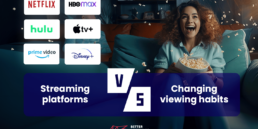When YouTube launched in 2005 it completely revolutionized how people discovered and watched online video content. Conversely – it also changed how videos were created and distributed around the web. The platform’s founders may not have fully envisioned what behemoth of a medium their brainchild would become in less than a decade, but Google apparently did, acquiring it in a mind-boggling US$1.65 billion deal.
While YouTube did chip away a big chunk of television’s market share, it’s clear today that it’s not exactly a direct competitor. Today the novel platform is a medium unto itself – governed by its own rules, speaking its own language, and being populated by specific genres and formats that only make sense within the platform.
YouTube has helped creatives around the globe unleash their potential with unprecedented freedom, enabling producing content without the creative control and financial shackles of an overseeing production entity. Add a possibility to earn some money on top of that and you’ve got a completely new business model.
What Is Video Monetization?
Many other video-hosting platforms have emerged since YouTube launched in 2005, but most of them operate based on the same key incentive for creators: elimination of middlemen between the creators and their audiences. That alone enables another important advantage – new ways to monetize video content.
Video monetization – ways of generating income through sharing videos online, usually using some kind of advertising, subscriptions, or direct transactions – or a combination of a few of these methods.
In this article, we will discuss the most popular monetization strategies.
YouTube Partners – AdSense Ads
Google, in a typical walled garden fashion, keeps you covered for all your advertising needs. When publishing your video content on YouTube, AdSense is the most intuitive way of monetizing your videos. But it’s also the most challenging one, as YouTube is restrictive regarding monetization, and grabs hefty commissions on top of whatever you earn.
With YouTube ads it’s important not to set your hopes too high – AdSense should not (and probably will never be) your main revenue stream. When creating content, your primary focus should be on creating high-quality, coveted content – money will come in time as a natural consequence.
Even if you don’t decide to display any ads on your videos, YouTube may still do this if your videos reach its desired target demographics. This reason alone should suffice to get you to set up your AdSense and start earning money (i.e. you must apply for monetisation first and be reviewed by YouTube to do this). All channels that have at least 4,000 watch hours in the previous 12 months and 1,000 subscribers are allowed to apply for monetization.
Advertising Video On Demand (AVOD)
Ad monetization is increasingly popular and most lucrative as your audience grows. That makes it ideal for hugely popular events. But instead of relying solely on YouTube AdSense, you can turn to one of the other AVOD options. For example, there are video platforms which enable its users to implement advertising video on demand.
Integrating your video platform with an independent Ad Server offers you greater control over your ad inventory – i.e. when, how frequently, and what kind of ads are displayed on your content. You can also sell and upload your own ads, and even integrate with other ad networks to maximize yield on your videos. But the greatest payoff here is you get to keep all your ad revenue and don’t have to share a penny with a platform like YouTube.
There are online video platforms which offer tools to craft custom AVOD platforms. Among other things, they save the hassle of developing an integrated paywall.
Pay Per View
Pay per view, also known as TVOD (transactional video on demand), is one of the alternatives to video monetization with YouTube ads. It’s the simplest pricing model whereby viewers pay as they pick a piece of content they want to see, and each video can be priced differently.
Such a pricing scheme is popular especially on video rental platforms (e.g. Movies & TV on Google Play or iTunes) and sports platforms: football, boxing and MMA. Such broadcasts are known to be a very lucrative business – the buy rates are really eye-watering.
Transactional pricing models are best fit for one-time, popular events: boxing or football matches, concerts, conferences, etc. Any one-time event that can generate significant interest can be a great candidate for PPV.
Last Words
The above methods mostly base on programmatic processes and require little human interaction. They are easily scalable and lend well for most videos as an effective way of monetizing views. However, specific video formats like product reviews, how-to’s, comparison videos, unboxing videos or tutorials may benefit from more personal touch to monetize trust. Stay with us – next week’s article on the video content monetization will broadly discuss these methods.
If you find this article valuable, you can share it on social media →
Read more about the VOD & OTT Industry!
March 7, 2024
7 reasons why is sports streaming becoming so popular
Learn more about the reasons why sports streaming is becoming more and more popular right now.
February 29, 2024
Why should streaming platforms adapt to changing viewing habits?
Discover the strategies through which streaming platforms adjust to changing viewing habits.
February 20, 2024
What is Titan OS and what do we know about it so far?
Explore what distinguishes Titan OS, a new smart TV operating system. Discover its unique features before giving it a try yourself.
Are you looking for a partner to build a Video Solution?
Leave your email and a short description about your project. We would gladly discuss different cooperation possibilities!





